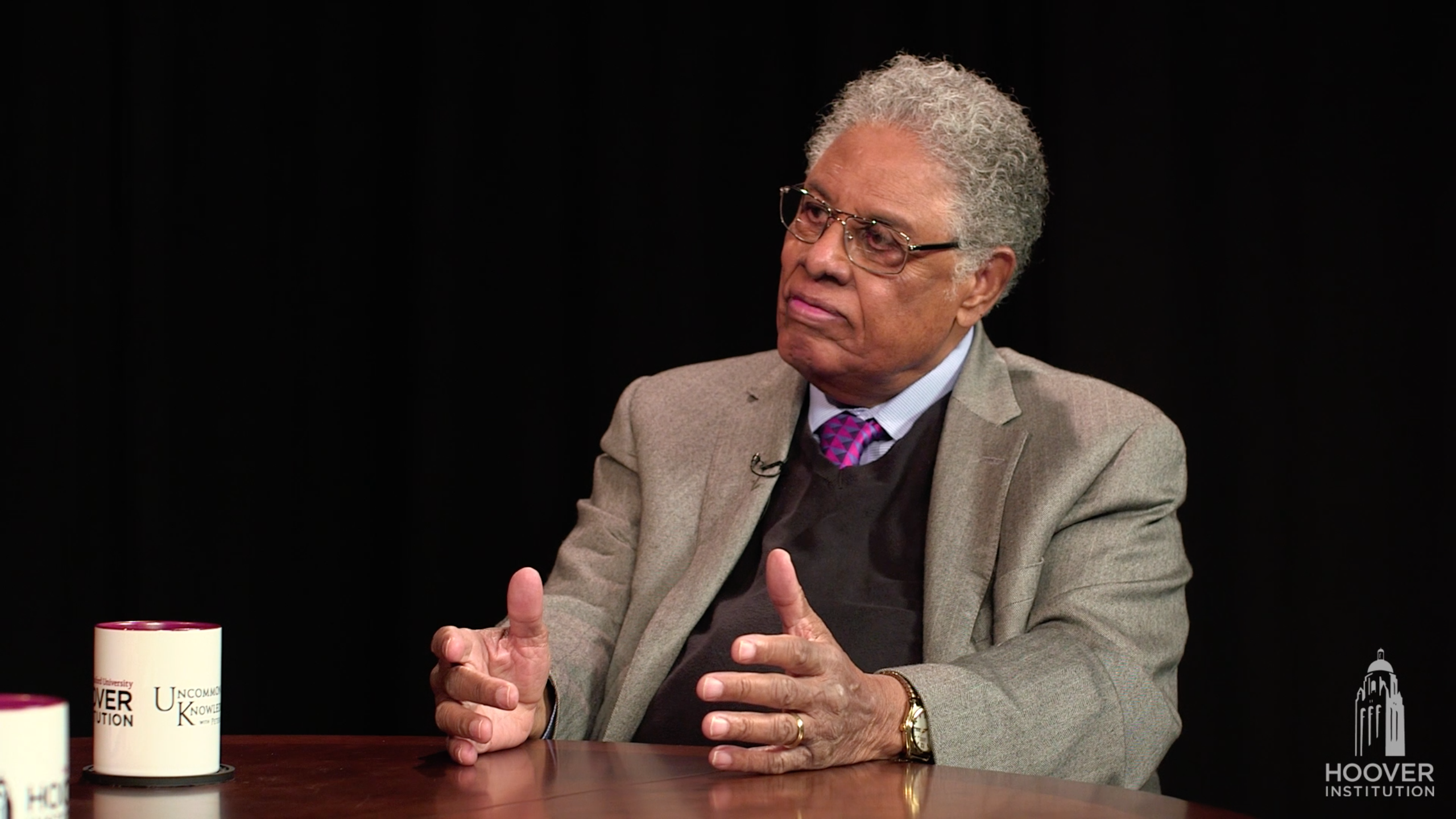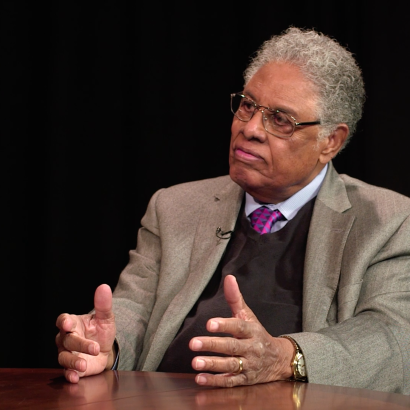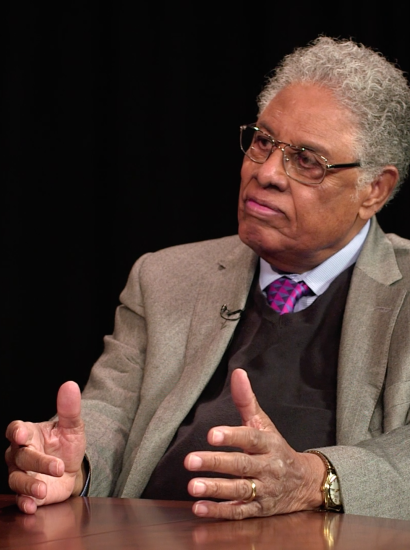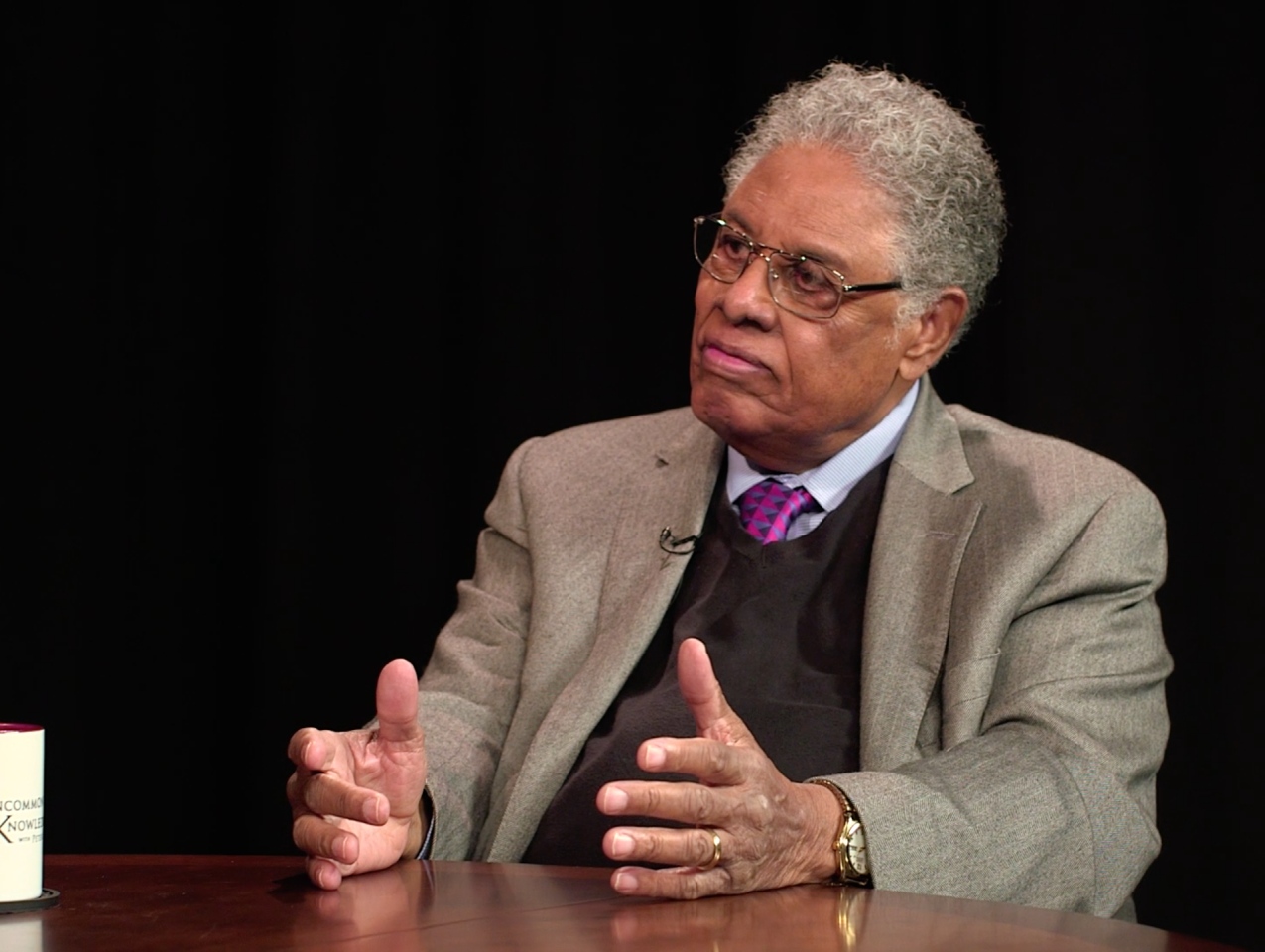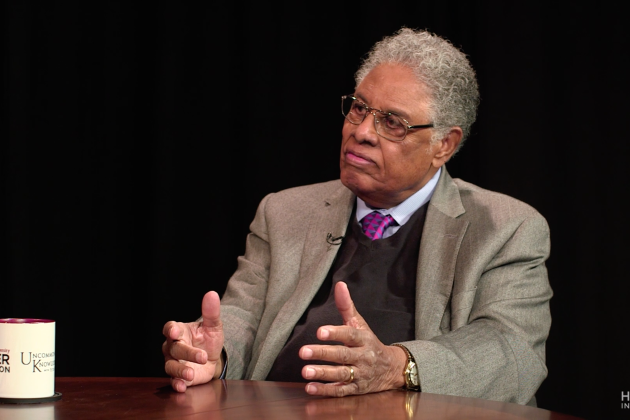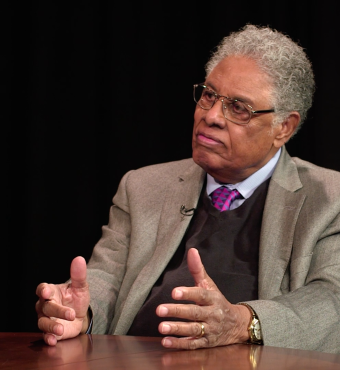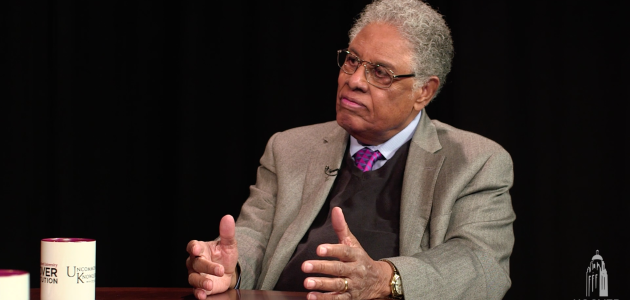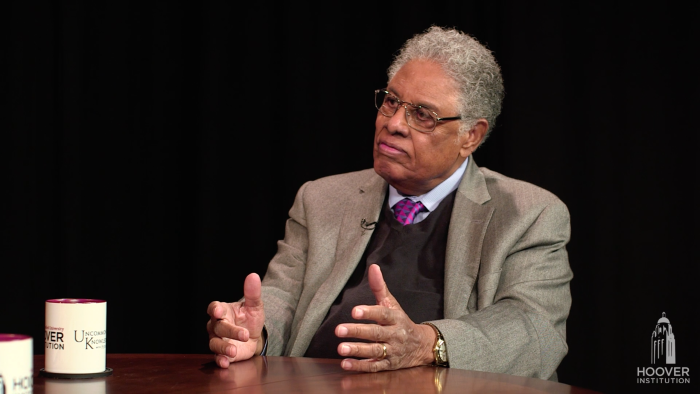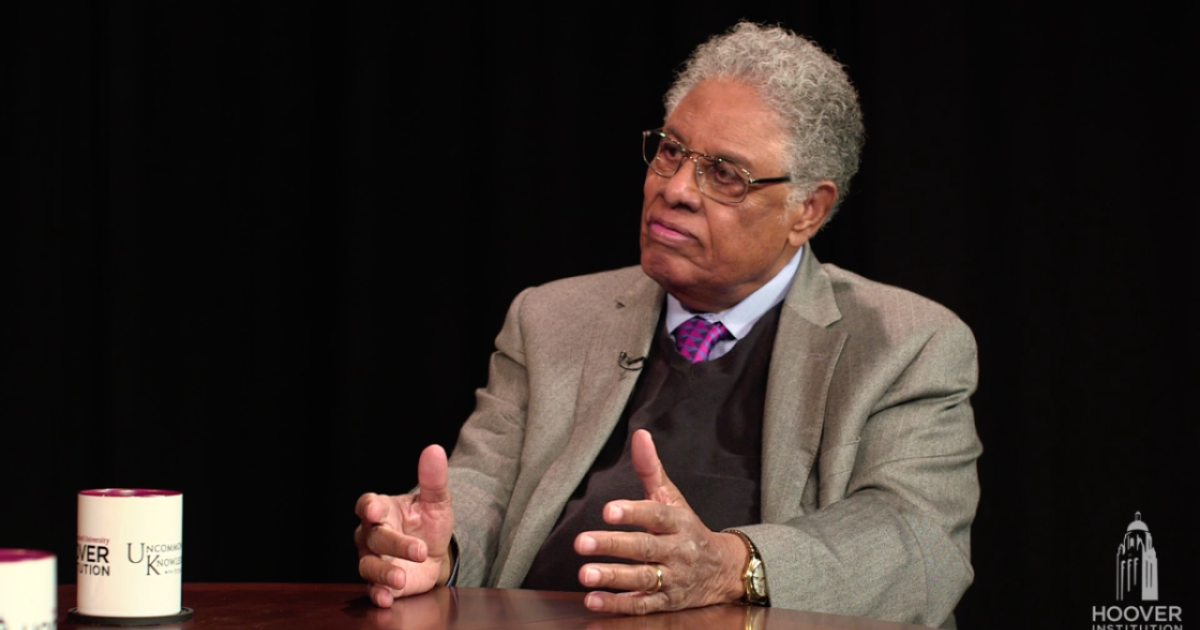- Economics
- Education
- History
- Law & Policy
- Politics, Institutions, and Public Opinion
Thomas Sowell turned 90 yesterday. An economist at the Hoover Institution, Sowell is possibly the most fascinating and productive scholar in the world.
I say that not as a junior colleague of Sowell (I am a mere 69), but as someone who has studied his work for 44 years. His scholarship covers a wide range of issues: income inequality, ethnic differences in economic performance, economic geography, poverty and economic growth, the destructive effects of the welfare state, the effects of affirmative action, the role of knowledge and information in decisions, incentives within the political system and within academia, and, more recently, the performance of charter schools.
The one constant on display through all these topics is an irrepressible mind digging through the data in order to understand the complex reality underneath. His intellectual process, plus his ability to write quickly, have resulted in dozens of books and hundreds upon hundreds of newspaper columns that have helped many of us learn. When I handed out my biography to students the first day of the class I taught at the Naval Postgraduate School (from 1984 to 2017)—with my Hoover Institution affiliation on it—a question I got from many was, “Do you know Thomas Sowell?” They mispronounced his last name, evidence that they knew about him from reading him rather than hearing about him.
Although I overlapped with Sowell in the early 1970s while I was an economics Ph.D. student at UCLA and he was an economics professor there, I didn’t know him well. Like my students at the Navy School, I got to know him through his written work.
One of my two favorite Sowell books is the first one I read, Race and Economics, published in 1975. I used it, along with Gary Becker’s The Economics of Discrimination, in a half-semester labor course I taught at the University of Rochester in 1977. I still remember two of the main points. One was that over the decades after slavery, U.S. governments, federal, state, and local, put a lot of barriers in the way of black advancement. President Woodrow Wilson, for example, re-segregated the U.S. civil service. Sowell also notes the absence of black people in the military. There were no blacks in the Marine Corps during World War II. The U.S. Navy discharged all blacks after World War I and didn’t relent until 1932 when it accepted them only for kitchen jobs. The army had only two black combat officers. Not two percent. Two.
The second point is that you can’t just assume that the natural state of things is for all races and ethnic groups to have identical economic performance. Culture and upbringing matter a lot. Age matters also. Sowell noted that one factor accounting for much of the difference in incomes across ethnic groups was differing ages. In the data he used for his 1975 book, the median age for blacks was 23 and was 47 for Russian-Americans. Age 47 is, of course, just short of the age at which earnings peak after growing fairly steadily.
In The Economics and Politics of Race: An International Perspective, published in 1983, Sowell took the next step, looking at race, ethnicity, and culture across the world. He wasted no time in getting to the issues. On the first page of the first chapter, titled “The Role of Race,” he wrote, “The most ghastly example of racial fanaticism in history was the Nazi extermination of millions of defenseless men, women, and children who were so similar to themselves in appearance that insignia, tattoos, or documents had to be used to tell the victims from their murderers.” In that one sentence can be seen the passion, power, and clarity of Sowell’s writing.
One group he wrote about in The Economics and Politics of Race is the overseas Chinese, a group that he showed was successful virtually everywhere they went. Imagine you’re an economist who notices that people who are productive thereby, through Adam Smith’s invisible hand, help others flourish. If you’re a naive economist, you might expect that those who deal with them would appreciate the productive group. But Sowell showed that that was not so with the overseas Chinese. He wrote, “The contrast between the economic value of the Chinese to various countries and the political resentment they engender among the poor and backward native populace lies behind historical vacillations in government policies toward them.” This is a theme he emphasizes in other parts of his work, as will be seen shortly.
Many Chinese immigrants came to the United States to take part in the 19th-century California gold rush but vigilantes prevented them from being miners. So instead, they became cooks and laundry men. I say “men” because, as Sowell noted, 95 percent of the 100,000 Chinese in the United States in 1880 were male. But that discrimination did not stop them in the long run. By 1959 the income of Chinese Americans passed the national average and the gap widened after that. Summed up Sowell: “Those who coined the phrase ‘not a Chinaman’s chance’ knew little of the resolution and perseverance of these people.”
Also fascinating in that book is the story of Jews in America. Sowell wrote that 70 percent of the almost 1.5 million Jews who entered America between 1881 and 1911 settled in New York City. On Manhattan’s Lower East Side, “half a million Jews were packed into one and a half square miles.” To put that in perspective, that’s five times the density of New York City today. They often slept three or four to a room and many spent their working days pushing carts through the streets.
One theme in much of Sowell’s work, a theme that he covered in Wealth, Poverty, and Politics: An International Perspective (2015), is that grinding poverty does not need to be explained because it “has been the lot of most of the human race for most of the existence of the species.” What needs to be explained is economic growth and wealth accumulation. And one of his explanations is economic geography.
“Geography is not egalitarian,” he wrote and then went on to show how true that is. The Sahara, the largest desert in the world, has isolated black people in sub-Saharan Africa. That makes economic growth harder to achieve than otherwise. He also pointed out that Africa, with twice the area of Europe, has a shorter coastline than Europe. It lacks the nooks and crannies that make for good harbors. Incidentally, that’s probably why my uncle and aunt, on their way to the Belgian Congo in 1941 to be medical missionaries, had to travel to to Cape Town first, rather than directly to the Congo. (They were captured by the German Navy, but that’s another story.)
If geography matters, so do incentives. One part of the 2015 book that is both hopeful and depressing is Sowell’s discussion of New York City’s prestigious Stuyvesant High School. The hopeful part is that in 1938 the proportion of black students attending Stuyvesant was almost as high as their representation in New York City’s population. The depressing part is that by 1971 the proportion of black students attending Stuyvesant had fallen to one-tenth the 1938 proportion. To what did Sowell attribute this dramatic change? Lyndon B. Johnson’s Great Society programs that expanded the welfare state. Welfare gives people a strong incentive to break up families or not form them in the first place.
Sowell has also been an outspoken opponent of affirmative action. In much of his writing he has argued that the policy hurts whites and Asians by discriminating against them, a fact that is fairly obvious even though some advocates of affirmative action seem to deny it. But he went further, arguing that affirmative action also hurts black people. How so? Consider college admissions. When colleges compete for black students to fill explicit or implicit quotas, black students who could make it at a lower-rung school end up at a higher-rung school where many of them have trouble competing. The result: many of them drop out, lose a few valuable years, and fail to get the all-important sheepskin.
My other cherished Sowell book is his Knowledge and Decisions, published in 1980. In my first year at UCLA, a 1945 article by Friedrich Hayek, “The Use of Knowledge in Society,” was on the syllabus for three of my classes. It was that important. I thought at the time that one could write a whole book based on, and extending, the insights in that one article. Thomas Sowell did more than think it; he did it, and the result is his 1980 book. In the Acknowledgements, he stated that the Hayek article contributed more than any other to the framework of his book. “In this plain and apparently simple essay,” he wrote, “was a deeply penetrating insight into the way societies function and malfunction, and clues as to why they are often and so profoundly misunderstood.
In the first chapter, he contrasted types of knowledge, pointing out that “an unlettered peasant is considered ignorant, however much he may know about nature and man, and a Ph.D. is never considered ignorant, however barren his mind might be outside his narrow specialty and however little he grasps about human feelings or social complexities.” I learned this first hand in the summer of 1969 when, at age 18, I worked in an underground nickel mine in northern Canada. I was the youngest person in an isolated mining camp with about 300 other men and, with two years of college under my belt, I was also the most formally educated. I arrived with an attitude of intellectual superiority but within two weeks my attitude was gone. A lot of these guys were quite bright and the ones I got to know applied their smarts to diamond drilling, the specialty in which about 20 of us were engaged.
Sowell then went on to consider the feedback mechanisms that tell us whether we have good or bad ideas. He noted that the prospect of bankruptcy focuses a business on how to have good ideas, that is, ideas that, when implemented, lead to revenues that exceed costs. In the social sciences, by contrast, “there is neither a swift nor a certain authentication process for ideas, and the only ultimate validation is whether the ideas sound plausible to enough people, or to the right people.”
My absolute favorite part of Knowledge and Decisions is a five-page section titled “The Physical Fallacy.” Sowell wrote, “Over the centuries, highly diverse consequences have followed from a belief in the invariable value of a physical object—a belief that can be characterized as ‘the physical fallacy’.” In medieval times, this fallacy led to a belief in a “just price” based, not on people’s actual valuations but, instead, on the cost of production. That led to usury laws, laws that ignore the fact that being able to buy an item now is more valuable than waiting a year.
Sowell also highlighted a famous post-WWII article by R.A. Radford, a British economist who had been a prisoner of war. (That article, incidentally, appeared on two of my syllabi in my first year at UCLA.) Radford noted that prisoners who saved their rations earned a premium by selling them to others who had used their rations quickly. Sowell beautifully stated the incredibly depressing fact about people’s attitude to these traders: “What is of wider significance is that those prisoners who performed these services were both widely utilized and deeply resented. The physical fallacy arose as spontaneously as the transactions which demonstrated its falsity.” That sounds a lot like his earlier insight about the overseas Chinese.
In recent years, Sowell has reduced his time spent on writing and turned to photography. But he still found time to write a book on charter schools. Fittingly, his Charter Schools and Their Enemies was published on June 30, his 90th birthday. In it, he documents the fact that black students who go to charter schools in New York have closed the black-white gap in educational achievement.
Thomas Sowell’s is a life well lived.







